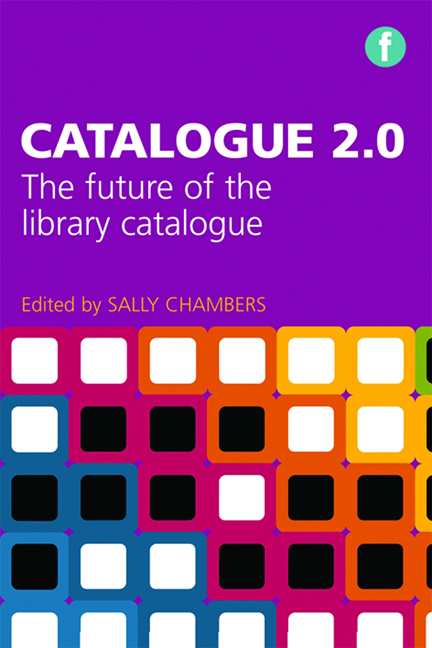Book contents
- Frontmatter
- Dedication
- Contents
- Acknowledgements
- Foreword
- Introduction
- Editor and contributor
- 1 Next-generation catalogues: what do users think?
- 2 Making search work for the library user
- 3 Next-generation discovery: an overview of the European scene
- 4 The mobile library catalogue
- 5 FRBRizing your catalogue: the facets of FRBR
- 6 Enabling your catalogue for the Semantic Web
- 7 Supporting digital scholarship: bibliographic control, library co-operatives and open access repositories
- 8 Thirteen ways of looking at libraries, discovery and the catalogue: scale, workflow, attention
- Index
8 - Thirteen ways of looking at libraries, discovery and the catalogue: scale, workflow, attention
Published online by Cambridge University Press: 08 June 2018
- Frontmatter
- Dedication
- Contents
- Acknowledgements
- Foreword
- Introduction
- Editor and contributor
- 1 Next-generation catalogues: what do users think?
- 2 Making search work for the library user
- 3 Next-generation discovery: an overview of the European scene
- 4 The mobile library catalogue
- 5 FRBRizing your catalogue: the facets of FRBR
- 6 Enabling your catalogue for the Semantic Web
- 7 Supporting digital scholarship: bibliographic control, library co-operatives and open access repositories
- 8 Thirteen ways of looking at libraries, discovery and the catalogue: scale, workflow, attention
- Index
Summary
Introduction
There is a renaissance of interest in the catalogue. This volume is evidence of that. Yet it comes at a time when the catalogue itself is being reconfigured in ways which may result in its disappearance as an individually identifiable component of library service.
This is because the context of information use and creation has changed, as it transitions from a world of physical distribution to one of digital distribution. In parallel, our focus shifts from the local (the library or the bookshop or …) to the network as a whole. We turn to Google, or to Amazon, or to Expedia, or to the BBC. Think of two trends in a network environment, which I term here the attention switch and the workflow switch. Each has implications for the catalogue, as it pushes the potential catalogue user in other directions. Each also potentially recasts the role of the catalogue in the overall information value chain.
The catalogue as an identifiable service
The catalogue emerged at a time when information resources were scarce and attention was abundant. Scarce because there were relatively few sources for particular documents or research materials: they were distributed in print, collected in libraries and were locally available. If you wanted to consult books or journals or research reports or maps or government documents you went to the library. However, the situation is now reversed: information resources are abundant and attention is scarce. The network user has many information resources available to him or her on the network. Research and learning materials may be available through many services, and there is no need for physical proximity. Furthermore, users often turn first to the major network level hubs which scale to provide access to what is visible across the whole network (think for example of Google, Wikipedia, Amazon, PubMed …). This is natural as interest gravitates to the more complete resource rather than a local selection, which seems increasingly partial. Studies show the high value placed on convenience and the importance of satisficing: users do not want to spend a long time prospecting for information resources.
- Type
- Chapter
- Information
- Catalogue 2.0The future of the library catalogue, pp. 179 - 202Publisher: FacetPrint publication year: 2013
- 2
- Cited by



